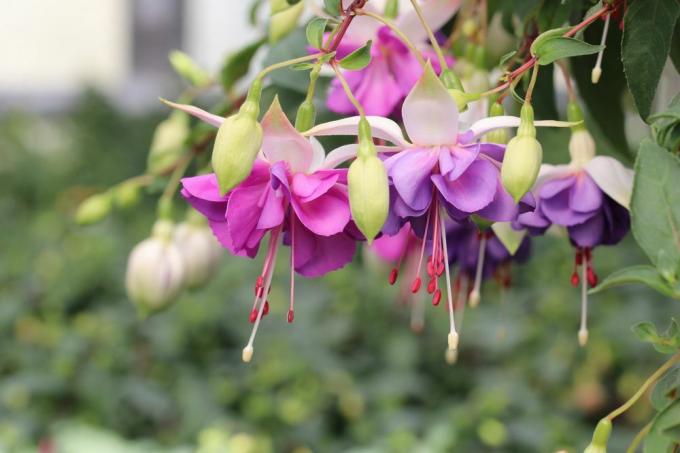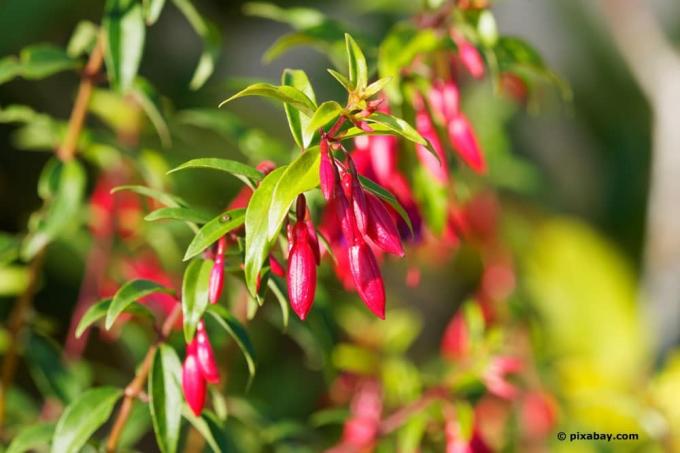
table of contents
- Are there hardy fuchsias?
- The flowering season of hardy fuchsia varieties
- Frost-proof is not the same as robust winter hardiness
- Winter temperature is crucial
- Preparation for the winter season
- Outdoor fuchsias suitable for cold winters
- Magellanic fuchsia (Fuchsia magellanica)
- Fuchsia microphylla
- Fuchsia procumben
- Fuchsia hybrid "Madame Cornelissen"
- Fuchsia "Delta Sarah"
Fuchsias are very popular among flower lovers. With good care, they bloom for a long time and are not demanding in terms of location. There are currently around 107 species of fuchsia. Most show their blossoms over the summer months and overwinter frost-free. If they are planted in the balcony box or in the garden bed, moving to the winter quarters is associated with effort. Fuchsias that are hardy would make work a lot easier. But do they exist? The plant guide explains.
Are there hardy fuchsias?
The question is clearly with one Yes to answer, even if most fuchsia varieties do not tolerate sub-zero temperatures. The hardy specimens are under the type of "
Outdoor fuchsia" to find. Some varieties of them can easily spend the winter outdoors. Whereas other varieties have to be relocated to warmer winter quarters in autumn at the latest.The flowering season of hardy fuchsia varieties
Even if the hobby gardener is not concerned with the amount of work involved in repotting / transplanting, it is hardy Compared to the non-hardy fuchsias, outdoor fuchsias are still a great asset to the Outdoor area. It blooms from late summer to late autumn and thus brings color to the mostly dreary, gray autumn days. Many specimens of hardy varieties bloom as early as May or June. Then they take a blooming break at the end of July / beginning of August, during which they gather new energy for the autumn bloom.

They are ideal for single planting between lower plants, but also between Perennials, Bushes and small hedges. If the garden or balcony loses color in late summer, it looks great in the gaps, where it extends the summer feeling with its strong, fresh color.
Frost-proof is not the same as robust winter hardiness
Nurseries and specialist gardeners often only indicate the property “hardy” or “frost-resistant”. As a customer, you shouldn't rely on this alone, because it can be immense difference are present. Although hardy fuchsia varieties are suitable for outdoor planting in the Central European winter months are touted, this is in many cases strongly dependent on the minus temperature and the length of icy temperatures addicted.
Winter temperature is crucial
Frostproof Specimens often only show up down to -5 ° C insensitive to cold. However, since winter temperatures have been significantly lower in recent years and experts believe that the If temperatures run out, it will be difficult for these fuchsia varieties to keep the winter safe with weeks of freezing temperatures survive.
Other varieties, on the other hand, are much more frost-resistant. When buying a hardy or frost-resistant fuchsia, you should ask accordingly up to what temperatures winter hardiness is given or limited to the purchase of the varieties listed in the lower part of the guide are. If you buy seeds, you can usually find this information on the description of the packaging.
Caution despite suitable winter hardiness
If you have decided on a fuchsia that is characterized by its high resistance to frost, you should still be careful. Under certain conditions, it reacts much more sensitively at low winter temperatures. For this reason, you should always keep the following tips in mind:
- No wintering outdoors for young plants
- Outdoor fuchsias should be planted in the garden bed or balcony box at the earliest when they are two years old
- There must be a strong rootstock
- Best planting time: between June and July so that the roots can anchor themselves until winter
- Place the roots in a planting hollow that is at least 20 centimeters deep
- In the event of illness or suspected growth disorders, frost-free wintering as a precaution
- On rainy days in late autumn, you should urgently avoid waterlogging if frost is imminent
Preparation for the winter season
Despite the hardiness of winter, the fuchsia requires some preparation for wintering outdoors. You should absolutely refrain from:
- In the second year of life: cover the soil over the root area with leaves, brushwood or straw
- Do not cover with foil under any circumstances, as this increases the risk of rot
- From the age of three: The plant is usually so robust that it can do without thermal insulation
- Only cut off withered flowers in autumn - they are only cut back in spring
- Do not fertilize in late summer, it could reduce the bloom formation for the coming gardening season
Outdoor fuchsias suitable for cold winters
Magellanic fuchsia (Fuchsia magellanica)
The magellanic fuchsia is one of the most frost-resistant fuchsia species. It can easily spend the winter outdoors at temperatures between -15 ° C and -18 ° C. Above all, the “Georg” variety, bred in Denmark, is very robust. In some gardens, this variety has withstood winter temperatures of -23 ° C without worrying.
Other hardy varieties of Fuchsia magellanica are:
- Riccartonii - has a captivating color brilliance and an extremely long flowering time
- Hawkshead - the only hardy fuchsia variety with white flowers
- Tricolor - has white, green and pink colored leaves
- Bouquet - flowers in blue and red, growing upright to a height of 30 cm
- Vielliebchen - impresses with two-tone flowers
- Lady Thumb - dwarf fuchsia with a maximum height of 40 cm, flowers red-violet
- Whiteknight Pearl - delicate pink flowers that shimmer white from a distance
- Fuchsia "Alice Hoffmann" - enchants with its bronze-colored leaves and half-double flowers
- Fuchsia regia ssp. reitzii

The fuchsia survives severe frosts well. While other fuchsia varieties “freeze back” and retreat to the ground near the rootstock, the branches of this variety remain there all winter. In the spring it drives them out again. In combination with an extraordinary vigor, it can reach a height of several meters. For this reason, it is very popular as a vine plant and privacy screen.
Fuchsia microphylla
Winter resistant, but possibly more sensitive than the Fuchsia regia ssp. reitzii presents the Fuchsia microphylla. It is a fairly new breed that impresses with its bright pink flowers and a strong contrast to the dark green foliage. So far, all that is known about outdoor wintering is that it has withstood temperatures of -7 ° C to -8 ° C without any problems. If the temperatures drop below, a Root isolation in the form of straw, brushwood or thick bark mulch.

Fuchsia procumben
The fuchsia procumben, which originally comes from New Zealand, is a wild species. It grows in the wild with yellow calyxes surrounded by green petals, as Ground cover. In the garden and on balconies it is planted as a hanging plant in pots and hanging baskets.

It can withstand mild winter temperatures down to -5 ° C without special protection. If it gets colder, it must be protected against the cold. Here it is advisable to procumben the Fuchsia in principle to one sheltered location to place. In addition, a bucket should always be placed on a wooden or styrofoam plate for thermal insulation.
Tip: Always keep in mind that Potted plants are significantly more affected by the cold because it hits them from all sides and, in the worst case, can freeze the substrate from top to bottom. Thermal insulation and a location sheltered from the wind are therefore advisable in principle.
Fuchsia hybrid "Madame Cornelissen"
This hybrid variety comes from Belgium. It blooms in red and white from July until late October. In addition, it has an upright, bushy growth and reaches a stature height of up to 80 cm with a maximum growth width between 70 cm and 90 cm.
It is extremely hardy, because temperatures down to -10 ° C do not bother it. If it is protected from cold winds, it can survive even cooler winter temperatures without freezing to death.

Fuchsia "Delta Sarah"
Not yet widespread in Germany, but good frost-resistant, is the "Delta Sarah". It impresses with its hitherto unique flower color in white with purple. Without protection against the cold, it can easily handle temperatures of -8 ° C. With winter protection made of brushwood, straw or leaves over the root area and on a sheltered one Location, it drives again in spring even after overwintering with temperatures of more than -15 ° C the end.

